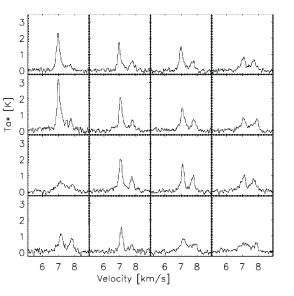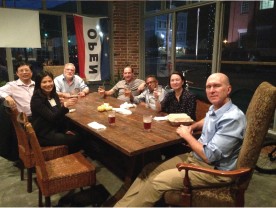 |
||||||||
|
NEWS FROM THE GREEN BANK OBSERVATORY QUARTER 2, 2017 |
||||||||
DIRECTOR'S NEWS |
||||||||
|
The last few months have seen many exciting developments at the Green Bank Observatory. Two new 3-mm wavelength instruments are having an excellent first full high frequency season - ARGUS, a 16-pixel spectroscopy contend, and MUSTANG-2, a 223-pixel feedhorn bolometer - and we are looking forward to publication of the instrument’s science results. World-class science coming from both our NSF-funded “open skies” time and the telescope time used by our partner organizations continues to be outstanding. Pressure for use of the GBT’s time also continues to increase, and with 17% of the proposers being new to the GBT! We also have a major new educational initiative underway, First Two, which works to increase retention of STEM students in their first two years of college, with a particular focus on first generation college students. Looking forward, we are preparing for the many and varied educational programs coming up, which range from REU students arriving for the summer, the PING (Physicist Inspiring the Next Generation) camp for students, a new Research Experience for Teachers program, and many, many more activities. And, of course, we are beginning to ramp up our plans for the fall workshop “Transformative Science for the Next Decades with the Green Bank Observatory,” and the accompanying 60th anniversary of sciences from our facility. Hope to see many of you at one or more of these exciting events! Karen O’Neil |
||||||||
UPCOMING EVENTS |
||||||||
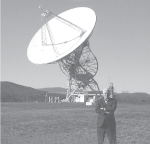 SETI ToursOur new SETI Tour celebrates Green Bank’s historic Search for Extra Terrestrial Intelligence. Piloted last summer, the tour sold out all but three offerings. The tour lasts about 3 hours and takes guests into the telescope control rooms where Project OZMA and Phoenix took place-just to name a few! Check out our summer tour schedule for 2017 online at: greenbankobservatory.org/events/ Chautauqua Short CoursesMay 22nd-25th, 2017 This 2.5 day course is designed to celebrate more than 50 years of contributions to the forefront of astronomy by the telescopes of the Green Bank Observatory and is open to educators of all disciplines. Presentations will emphasize recent research at Green Bank in two areas: pulsar studies, that could lead in the near future to direct detection of gravitational radiation and hydrogen studies that reveal the structure and evolution of galaxies and their dark matter halos. Learn more: greenbankobservatory.org/education/teachers  Space Race RumpusJune 9th-11th, 2017 It’s a festival. It’s a race. It’s group rides. It’s a clinic. It’s a fundraiser. It’s a tradition. The 6th Annual Space Race Rumpus is a 3-day family music and cycling festival hosted by the Northern Pocahontas Wellness Center at the Green Bank Observatory. If you’ve ever wanted to bring your bike to explore the site trails or miles of scenic roads in Pocahontas County, now’s the time! Registration is now open. Find out more: www.spaceracerumpus.org 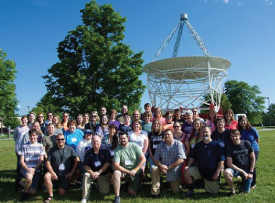
ESS Teacher’s PassportJune 18th-July 1st, 2017 ESS Passport is an amazing professional development program for West Virginia science teachers to prepare them to teach Earth and Space Science. Funded by the West Virginia Math Science Partnership program, the Earth/Space Science Passport workshop provides West Virginia science teachers with professional development in Geology, Meterology and Astronomy concepts that will enable them to teach a new mandated ninth grade Earth/Space Science course. Over a twoweek residential workshop teacher groups rotate through three-day directed studies in each of these content areas. The Green Bank Observatory provides the Astronomy course. Learn more at greenbankobservatory.org/education/teachers/ Pulsar Search Collaboratory CampJuly 10th-17th, 2017 The Pulsar Search Collaboratory (PSC) is a joint project between the Green Bank Observatory and West Virginia University (WVU), funded by the National Science Foundation (NSF). The goal of the PSC is to give high school students, and their teachers experience doing real research. Learn more at greenbankobservatory.org/education/student_research/ Just last year, a new documentary (www.lgmfilm.com) called “Little Green Men” was released. The film follows PSC high school students searching for pulsars using data from the Green Bank Telescope. 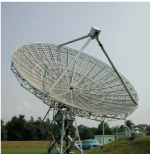 Physics Inspiring the Next Generation: Investigating the Cosmos Summer Camp ExperienceJuly 30th- August 5th, 2017 Current 8th graders (rising 9th-graders) will be on location in Green Bank, WV, at NRAO’s world famous Green Bank Telescope. Students will be immersed in the research activities of this national research center. While in residence, students will work in small teams supported by an undergraduate student mentor and an NRAO staff scientist (astronomer, physicist, engineer, etc.) to conduct research by observing the universe with a 40-foot diameter radio telescope. For more details, visit: greenbankobservatory.org/education/student_research/ Observer Training WorkshopSeptember 18 - 23, 2017 The Green Bank Telescope (GBT) Observer Training Workshop series provides the essential skills and knowledge needed to use the GBT and maximize its scientific output. We’ve reached capacity for the Spring 2017 training, but there will be plenty of openings for the next session, set for the week of September 18th, 2017. A separate announcement will be made when registration opens for this event. Transformative Science for the Next Decades with the Green Bank ObservatoryOctober 16 - 20, 2017 Big Questions, Large Programs, and New Instruments: With new instruments and excellent performance, the 100m Green Bank Telescope is only just reaching its full potential. On this 60th anniversary of the ground breaking for the Green Bank Observatory, we are holding a workshop looking toward the next 10, 20, and even 60 years of the Green Bank Observatory, and invite the community to attend and aid us in planning the future. For more information, please visit our Web site at greenbankobservatory.org/transformative-science/ |
||||||||
NEWS |
||||||||
ARGUS camera for GBT 3mm spectroscopy swings into actionThroughout the winter months of 2016-2017 the new ARGUS 16-pixel camera for 3mm spectroscopy has been in regular use on the GBT. The camera was developed by Sarah Church (Stanford University) and collaborators under a grant from the NSF. The first map made during commissioning was shown in the previous GBO newsletter (greenbankobservatory.org/green-bank-observer-vol-1-issue-1/). Data from a number of projects are now in the hands of the PIs for reduction and analysis.
The figures (top) show preliminary results from a measurement by Y.-m. Seo (USRA, NASA-JPL) and collaborators of star forming cores in the Taurus molecular cloud B7. The ARGUS footprint (green circles the size of the HPBW) is shown against the NH3 map of the region also from the GBT (Seo et al 2015). The white circle shows the NH3 beam at 24 GHz. Preliminary HCO+ (1-0) spectra at 89 GHz from ARGUS at the location of the green circles are shown in the right panels. They show strong blue asymmetry which reveals infall motions toward the core. The flow seems to be non-spherical and quite complex. Excitation conditions for HCO+ may also be quite complex as the strongest line is on one side of the core and not at the center. These spectra are from one ten-minute snapshot made with ARGUS. More detailed results from ARGUS will be presented in the next few newsletters. Reference: Seo, Y.-M., et al. 2015, The Astrophysical Journal, 805:185 (24pp), 2015 June 1 INCLUDES programIn October 2016, the Green Bank Observatory received an award from the INCLUDES initiative (NSF #1649323), to build the First Two Network. The problem First Two addresses is post-secondary attrition. Degree completion is key to producing a diverse STEM workforce: Increasing the retention of STEM majors by 25% will “generate three quarters of the targeted 1 million additional STEM degrees needed over the next decade” (PCAST, 2012). Well-shy of half of all undergraduate students who enter STEM majors complete degrees in STEM, and that it is during the first two years of college that most students drop out of the STEM The effects are worse with First Generation College (FGC) students, who not only leave STEM programs but often quit their post-secondary education altogether. Since roughly one third of all post-secondary students are FGC students, addressing the underlying challenges they face could significantly broaden participation in the STEM workforce. The First Two Network targets rural first generation students who major in a STEM related course of study. Beginning summer 2017, we pilot two early research experiences (for rising freshmen), and an academic year course that builds science process skills, communication skills and leadership expertise. An innovative component of FIRST TWO is the creation of Hometown STEM ambassadors—students who participate will be prepared to mentor their peers, and also conduct outreach in their home school districts. Finally, there are many studies that inquire into the factors that correlate with post-secondary retention in general, and with STEM attrition specifically but few that focus on rural students. One of our working groups is developing a rigorous educational research project that can advance understanding of the factors affecting rural students’ entry into and persistence in STEM career pathways. For more information about our INCLUDES program, please visit our Education pages at greenbankobservatory.org/education/ GBT helps find Lost Spacecraft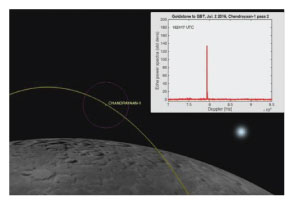 Finding a tiny lost space-craft at a distance of 270,000 miles away may seem impossible, but NASA scientists have done just that. Using a new radar technique, they have located India’s Chandrayaan-1 spacecraft which has been lost since August 2009, the last time any communication was received from it. Chandrayaan-1, India’s first mission to the moon, is a very small cube about five feet (1.5 meters) on each side — about half the size of a smart car. JPL scientists used NASA’s 70-meter (230-foot) antenna at NASA’s Goldstone Deep Space Communications Complex in California to send out a powerful beam of microwaves directed toward the moon. Then the radar echoes bounced back from lunar orbit were received by the 100-meter (330-foot) Green Bank Telescope in West Virginia. The successful rediscovering of Chandrayaan-1 provides the start for a unique new capability. Ground-based radars using large antennas including the GBT could be used as a collisional hazard assessment tool and as a safety mechanism for spacecraft that encounter navigation or communication issues, in future robotic and human missions to the moon. Read the full press release online: greenbankobservatory.org/finding-a-lost-spacecraft/ GBT Observations Compound Intersellar Helium Ionization ProblemWarm ionized gas is a major constituent of the Galactic interstellar medium, observable through both optical and radio emission lines. To maintain its ionization it requires about 80% of the ionizing radiation from all OB stars in the Galaxy; this is presumably supplied by UV photons leaking from HII regions. This UV leakage should be sufficient to fully ionize Helium in the diffuse ionized gas, but instead, the fractional ionization of He appears to be relatively low, in the range of 10-20%. Recent observations with the Green Bank Telescope (GBT) compound this problem. A set of H and He recombination lines was observed toward the envelopes of three ultra-compact HII regions that are still embedded in their molecular clouds. The envelopes have emission measures an order of magnitude greater than that of the warm ionized gas, and are just a few parsecs away from the central stars, which have type O5 or earlier. The data indicate that He is not uniformly ionized in the HII region envelopes. In two cases helium in the envelope is only 30% and 50% ionized. After ruling out the possibility that the helium may be doubly ionized, the authors conclude that the most likely explanation for the discrepancy is selective absorption of helium-ionizing photons by dust. “Helium Ionization in the Diffuse Ionized Gas Surrounding UCHHII Regions” D. Anish Roshi, E. Churchwell and L. D. Anderson, accepted by the Astrophysical Journal. 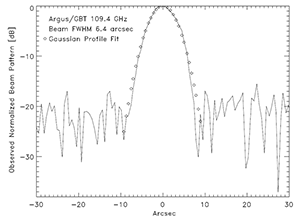 GBT hits new performance milestone at 109 GHzWith the installation of the Argus 16-pixel receiver covering 75-115 GHz on the Green Bank Telescope (GBT), it is now possible to characterize the antenna beam above 100 GHz, where the use of the active surface and out-of-focus holography are critical to the telescope’s performance. A recent measurement (2017 March 23) in good weather conditions at 109.4 GHz yielded a FWHM beam of 6.7 arcsec and 6.4 arcsec in azimuth and elevation, respectively. This corresponds to 1.16 Lambda/D at 109.4 GHz, which agrees well with the low-frequency value measured at 9.0 GHz. After applying the standard antenna corrections (focus and active surface), we find no measurable degradation of the beam of the GBT at its highest operational frequencies. These results are discussed in more detail in the GBT Memo #296: library.nrao.edu/public/memos/gbt/GBT_296.pdf  GBO Post-doc Jennifer Weston Wins dissertation prizeJennifer Weston has just won the 2016 Robert L. Brown Outstanding Doctoral Dissertation Award. The award presentation, and her talk on the research which led to the award, will be in Charlottesville on April 13. The Robert L. Brown Outstanding Doctoral Dissertation Award is administered by AUI and the NRAO on behalf of Bob Brown’s friends and family to honor Bob’s life and career. The Award is given each year to a recent recipient of a doctoral degree from any recognized degree granting institution in the United States, and is substantially based on new observational data obtained at any AUI operated facility and considered to be of an exceptionally high scientific standard. Featured Receiver - ASIAA 800 MHz HIM Receiver ArrayIn November of last year, a collaborative effort involving representatives of the Academia Sinica Institute of Astronomy and Astrophysics, University of Wisconsin, NRAO, and the Green Bank Observatory gathered to review designs for a proposed focal plane array for the GBT. The proposed receiver system improves the observing efficiency in the 700 to 900 MHz band by replacing the single corrugated prime focus feed with seven short backfire antennas each with an individually cooled cryogenic dewar. The group faced many technical challenges, especially the weight and moment limits of the GBT prime focus feed arm. Some of the margins were razor thin and thus the group plans more modeling of the structure for a better understanding of the wind load analysis. The progress was such that the GBO review committee conditionally passed the review, which allowed the University of Wisconsin to seek funding to construct and commission the instrument through the NSF Advanced Technology Initiative. To ensure the receiver will fit in the prime focus tepee, a trial fit mockup is planned before modifications to the existing infrastructure can proceed. As part of the contract, the GBO cryogenic group also developed two 7.5 HP compressors and a technique for combining the flow onto a single set of lines.
The group presented details of the primary scientific driver, Baryonic Acoustic Oscillation observations, and other potential uses for the receiver. Characteristic perturbations in the cosmic background radiation verified the presence of Baryonic Acoustic Oscillations in the aftermath of the Big Bang. This same phenomenon alters the power distribution of redshifted neural Hydrogen where the effect produces a characteristic wiggle in the spectrum. From this wiggle, the parameters for dark energy can be constrained in cosmological models and knowledge gained on the formation of galaxies in the early universe. To make a detection, precise knowledge of the telescope beam is required. Thus, the GBT with its clear aperture and size, is competitive with other efforts specifically designed to study BAO. Other potential uses include searches for pulsars and fast radio bursts owing to improved mapping speed. By this summer, we should learn whether the University of Wisconsin proposal will be awarded the funding to proceed to the next phase of receiver construction. New Phased Array Feed Successfully Commissioned on the GBT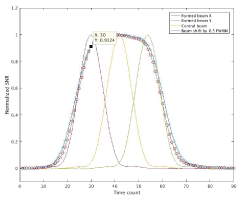 The L-band cryogenic Phased Array Feed (PAF) receiver, with nineteen dual-polarization crossed dipoles located in the focal plane of a reflector antenna, was commissioned on the GBT in March 2017. The testing has confirmed the predicted excellent performance of the PAF, and has also commissioned the unformatted digital link technology developed by NRAO’s Central Development Lab. Phased Arrays employ a technique in which many small antennas can be combined together to perform the function of a single large antenna. By combining the small antennas together with adjustable phase and amplitude, the properties of the composite antenna beam can be changed (beamwidth and beam direction). Since the beamforming is accomplished by FPGA-based digital signal processing, multiple beams can be simultaneously formed increasing telescope throughput (in this case seven beams in each polarization were formed). The PAF was developed as part of a collaboration consisting of NRAO, GBO, West Virginia University, and Brigham Young University. More information will be forthcoming as data results are analyzed. Students track anomalies in the fading of Cassiopeia AEvery summer since 1992, Prof. Dan Reichart of the University of North Carolina (UNC) and a small group of astronomy faculty have taken 15 mostly undergraduate students through an intense, one-week workshop at the Green Bank Observatory called “Educational Research in Radio Astronomy” (ERIRA). While on site the students are engaged in several observing projects with the 40 Foot Telescope including observations of Cassiopeia A, Taurus A, and Cygnus A. 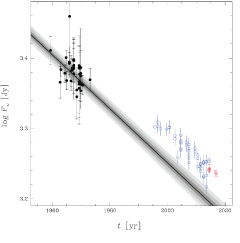
The 40 Foot is meant to be an educational telescope, and it has been used to inspire and educate thousands of teachers and students over the years, but Reichart and company, have managed to squeeze some publishable science from the telescope! While most users of the 40 Foot Telescope experience a completely old-fashioned system, where data is recorded on a chart recorder, the ERIRA team has figured out how to digitize both the position of the telescope and the data output. This has allowed them to run some sophisticated data reduction algorithms that have resulted in calibrated measurements of the flux density of Cas A. In recent years, the ERIRA students have also used the robotic 20 Meter Telescope. Using student data collected on both of these GBO telescopes, the team has been able to sort out the historic fading of Cas A. (The fading of a supernova remnant is expected because it is expanding and radiating its energy away.) In a paper recently accepted by the Monthly Notices of the Royal Astronomical Society, authors Adam Trotter, Dan Reichart and others present 20 years of data on Cas A and other sources. They found a slightly lower rate of fading over-all than reported by Baars et al (1977). In between the late 1950s and late 2010s, Cas A faded at an average rate of 0.670 +/- 0.019 %/yr in L band. They also report a finding (at the 6.3σ credible level) that Cas A did not fade at a constant rate over this time. Rather, “Cas A faded at a faster rate through at least the late 1960s, brightened, or faded at a much slower rate, and then resumed fading at a similarly fast rate by, at most, the late 1990s”. A pre-print of their paper, “The fading of Cassiopeia A, and improved models for the absolute spectrum of primary radio calibration sources”, is available on astro-ph at arxiv.org/abs/1704.00002 References 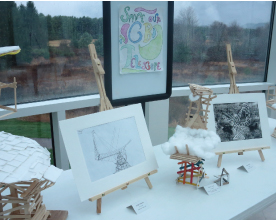
Student Art ExhibitTo show support for the Green Bank Telescope, Green Bank Middle School students created some amazing 2-D and 3-D art projects. From intricate Popsicle-stick GBT models to precise blueprint-style charcoal drawings, works included a wide variety in chosen mediums. This project was lead by the art teacher, Alison Flegal, who created the project as a way for students to voice their support for the Green Bank Telescope in response to 2016’s Environmental Impact Statement (EIS) Call for Public Comments. In fact, a few of the works were submitted formally and included among the hundreds of letters. In March, the Green Bank Science Center hosted an art exhibit opening for these works, which are now on display in the lobby. During the opening, these young artists presented their work to both staff and the public. The Green Bank Observatory is an education partner of the Green Bank Elementary Middle School as part of our outreach program. New online reservation system coming soon!Coming Soon! The Green Bank Software Development Division will soon release the new Green Bank Observatory Reservation System (GBORS), replacing the previous BOS system and offering expanded capabilities. GBORS will accept reservation requests for everything from an overnight stay to planning a conference. When launched, look for it on our website!
|
||||||||
Proposal NEWS |
||||||||
Upcoming call for GBT proposals (18A)The Green Bank Observatory (GBO) will invite scientists to participate in the next Call for Proposals for the Green Bank Telescope (GBT). The deadline is August 1st, 2017 for Semester 2018A. Response to the 17B Call for GBT proposalsThe 1 February 2017 call for proposals to use the GBT beginning the second semester of 2017 elicited requests for 6647 hours in 100 individual proposals. In the 3mm band there were requests for 1,148 hours for spectroscopy and continuum using the new ARGUS and MUSTANG2 cameras, as well as an additional 191 hours for spectroscopy and VLBI with the 2-pixel”W band” receiver which covers the lower part of the band. Demand for the7-pixel “K-band” camera that covers 18-26 GHz continued to be strong, at 645 hours. More than 3,000 hours were also requested at frequencies below 2 GHz for programs of spectroscopy and pulsar studies. There were a number of proposals for joint observations with ALMA, the JVLA,Fermi, and other instruments.
|
||||||||
HISTORY |
||||||||
A bit of history: The Green Bank Interferometer confirmed Einstein’s theoryEinstein’s theory of gravity (also known as General Relativity) predicts that the path of a ray of light (or that of a radio wave) will bend when it passes near a massive object. This was first tested in 1919 by Sir Arthur Eddington, who organized an expedition to observe star positions during an eclipse of the Sun from islands near the coast of Africa. Observing stars close to the edge of the Sun is normally impossible, but during an eclipse, the Sun is blocked out and stars nearby can be observed. The 1919 experiment confirmed the theory and made an instant celebrity of Einstein and of General Relativity. With radio astronomy there is no need to wait for an eclipse. Strong radio sources can be detected only a few solar diameters from the Sun. A radio experiment was done in 1974 by Ed Fomalont and Dick Sramek using the Green Bank Interferometer. At the time the GBI consisted of the three 85-foot dishes and a fourth dish, 45 feet in diameter, located 35 km south of Green Bank near Huntersville. With this combination, angles between objects can be measured to a few hundredths of an arcsecond. 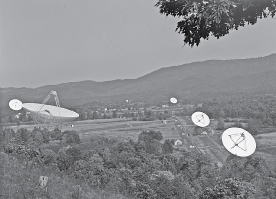
The measurements were made when the Sun happened to be passing near a group of 3 radio-bright galaxies in 1974. Measurements were made over a period of 12 days and comparisons could be made of how the relative positions of the objects changed as the Sun moved through the vicinity. The measurement confirmed Einstein’s prediction with an accuracy of about 1 percent, the most accurate measurement that had been done up to that time. In the photograph of the three 85-foot telescopes that currently hangs in the GBO cafeteria, shadows of the receivers are near the center of the dishes, meaning that they are tracking near the Sun. This is how the dishes would have looked during the relativity experiment. Since the 1970s, radio measurements of the gravitational deflection have been done with increasing accuracy using interferometers that span thousands of miles, including the NRAO VLBA (“Very Long Baseline Array”) and antennas in many different countries around the world. By now, Einstein’s prediction has been confirmed to within about 0.02 percent. Fomalont’s experiment was described in a paper in the Astrophysical Journal, volume 199, page 749, of August 1, 1975.
|
||||||||
MEET THE STAFF |
||||||||
Thomas Chamberlain, Software Engineer
How long have you worked at GBO? What led you to applying for the position? What project are you currently working on? What has been another favorite project you have worked on since you have been here? If someone asked you to describe Green Bank, how would you describe it? I also don’t think the RFI restrictions were that hard to get used to. When I had a cell phone I was always connected to people, but that adds a lot of pressure -- if you’re always able to be contacted, then the expectation becomes that people should be able to contact you at any time. That’s not the case here. There’s a sense of freedom that I don’t think I’ll have at any point in my life after my time here: the freedom that comes with being disconnected.
|
||||||||
ENGAGE |
||||||||
Become a MemberWant to help support the Green Bank Observatory? We now have a new Membership and Donation program! Check out the variety of opportunities found at greenbankobservatory.org/engage/
|
||||||||
Careers |
||||||||
|
The Green Bank Observatory employs 100 people on a year round basis, and an additional 40 people in the summer time. While most people tend to think of Green Bank as hiring scientists and astronomers, it takes a village to run the scientific and educational programs. While we have staff from all around the world, the majority of our employees (80%) were born in West Virginia, and roughly 60% of the staff are from Pocahontas County. Of the astronomy staff, 40% are female (compared to the national average of less than 30%). We are committed to a diverse and inclusive work place culture that accepts and appreciates all individuals. Please check out our current listings here: greenbankobservatory.org/careers/
|
||||||||
|
Green Bank Observatory :: 155 Observatory Road P.O. Box 2 - Green Bank, WV - 24944 General Contacts Newsletter Information, submissions Public RFI Questions: The GREEN BANK OBSERVATORY is a facility of the National Science Foundation and is operated by Associated Universities, Inc. You are subsctbed to The Observer because of previous affiliation with NRAO E-News publications. |
||||||||

